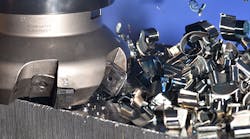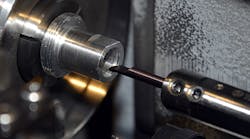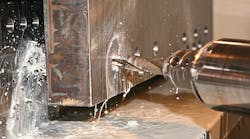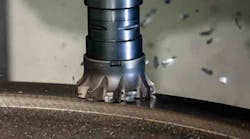Early field experience milling large, nasty castings and forgings indicates that negative/positive cutters can materially raise the removal rate, double edge life, and put an end to catastrophic insert failure that stalls production and can damage the workpiece in large-scale work. The experience covers facing long, abrasive 15-5 forgings that weigh tons, refurbishing big forging dies in tempered FX, and cubing 20-foot manganese steel railway castings.
The cutters making the difference are heavy-duty Ingersoll Cougar-Mill facemills with Power-Shear inserts, only lately commercialized. Besides the negative/positive cutting geometry, the cutters feature improved, wedge-type seating that mechanically locks the inserts in place to better withstand heavy cutting loads. The cutters are available in standard diameters up to 14 inches.
Here are three of the more punishing beta-site applications for this new cutter:
Die refurbishing — A Davenport, Iowa, mold shop reported 70% higher throughput and double the edge life when re-facing worn forging dies in hardened FX steel (Rc 38-42). The interrupted cuts in such hard stock make the application especially punishing on both tooling and machine. Accordingly, the operation is run on a very rigid boxed-way 30-HP gearhead vertical mill.
The previous practice was to use double-side button or square inserts in 4-inch cutters and to run no faster than 420 SFM, 14.5 IPM feed (0.006 advance/tooth [APT]) and 0.150-in. depth of cut (DOC.) Raising either parameter in any combination caused unacceptable shock to the machine and catastrophic insert failure. With a 4-inch Cougar-Mill cutter body and Power-Shear heavy-duty inserts, the shop now feeds 25% faster and 66% deeper. Standard parameters now are 420 SFM, 19.2 IPM (0.008 in. APT) and 0.250 in. DOC.
Now, the principal failure mode is flank wear, with only minor chipping. “At the heart of this particular success,” explained Ingersoll product manager Don Yordy,” is the thickness and strength of the insert cross section coupled with a free-cutting axial rake geometry. The result is smoother chip formation and entry, even through interrupted cuts as the tool passes over the dies’ impressions. The bottom line is higher feed rates, deeper cuts and longer edge life.
Fast-track milling of railroad parts — Near Chicago, voestalpine Nortrak is the North American market leader in turnout technology, manufacturing rail-track components for railways, metros and tramways. It has doubled the material removal rate (MRR) on 20-foot manganese steel castings, with no loss of tool life. Even though the castings have the typical sand inclusions, the 8-inch Cougar-Mill runs at 350 SFM, 30 IPM (0.015 in. APT) and 0.090 in. DOC. Moreover, it completes the pass even when an edge is chipped. With the previous heavy-land button cutter, feeding any faster than 15.5 IPM ruptured the buttons, forcing an emergency retraction to avoid damaging the workpiece.
The plant manager identified the key benefit of the new mill as ‘survivability.’ No longer does the operator need to stop halfway through a pass to replace hot inserts and possibly to rework the part. The retooling is saving the company more than $200,000 a year in all-in machining costs including labor, machine time and consumables.
Pumping up throughput on forgings — And near Pittsburgh, a supplier of large rectangular billets used in high-pressure pumps for the oil-and-gas industry has doubled the edge life at the same MRR when squaring up 15-5 series stainless steel and 4330 mod steel slabs. It is using the heavy-duty neg/pos insert for the 4330 mod steel, and the general-purpose, landed pos/pos insert for the gummier 15-5 stainless steel. The same Cougar-Mill cutter accommodates both inserts.
Called ‘sticks’, these parts measure 24 feet long and require machining on all four sides. In 12- and 14-inch diameters, Ingersoll Cougar-Mills square up the forgings at 282 SFM, 19 IPM, (0.018 APT) and 0.350 in. DOC. The high depth is necessary to get clear through the oxide crust on the first pass.
A critical problem with the previous cutter was the inadequate edge life and occasional edge rupture. The cutter had wedge-type insert seating, but with a small contact area and only frictional engagement between the wedge and the insert.
“The longer insert life here is due more to the carbide grade and coating than the cutting geometry,” according to Yordy. “However the elimination of rupture stems directly from the Cougar-Mill’s more secure mechanical clamping engagement between insert and wedge.”
Wedge clamping plus mechanical lock — In the Cougar-Mill seat design, the insert is locked in place mechanically. A raised “boss” on the wedge engages with shallow detents on the insert. Tightening the wedge screw preloads both the sides and bottom of the cutter’s pocket to stabilize the insert despite heavy cutting forces.
“Even under the severest of cutting loads, that insert is not going anywhere,” Yordy said.
The new wedge design also simplifies insert indexing and change-out. The wedge screw is captive, and needs only two turns for indexing or replacement. That saves substantial operator time vs. handling loose screws and hot inserts as required for change-outs in many heavy-duty facemills.
Field tests just completed — Ingersoll began field-testing the Cougar-Mills in mid-2013 and commercialized the line in spring 2015. The standard line includes diameters up to 14 inches. Besides the secure seating, the same Cougar-Mill cutter can accommodate several different insert styles and grades. Styles in the heavy-duty neg/pos inserts include standard and serrated. Styles for general-purpose, landed pos/pos inserts include standard and wiper.










